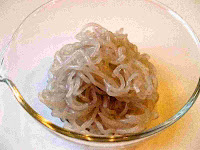Konnyaku is jelly-like yam (Amorphophallus konjac) cake eaten for its texture rather than for its taste. Yet while this is true if you are eating inexpensive mass-manufactured konnyaku, fresh konnyaku made in the traditional method has a delicate flavor and it is well worth trying if you ever have an opportunity, such as at a morning market in the countryside of Japan. It will make you wonder about all those konnyaku you have been eating.
When growing up, I was repeatedly told that konnyaku would cleanse your intestines and was good when eating shellfish (to get rid of sand). Konnyaku yam cake is 97% water and the other 3% is glucomannan, which is non-soluble fiber in konnyaku products. Konnyaku controls absorption of cholesterol, carbohydrates and fat (good for prevention of diabetes and hyperlipidemia) while sending a signal that your stomach is getting full, and carries away harmful substances from your body. It is low in calories (5-7 kcal/100 g) and is known as a food of choice for dieting.
When using, boil konnyaku first to remove the smell of the solidifying ingredient (calcium hydroxide).
Ita konnyaku / slab-shaped konnyaku
When people say konnyaku, this is the form associated.
Shirataki or ito konnyaku / konnyaku noodles
Konnyaku in small ball shape and thin slices are widely available --- at least in Japan.
Konnyaku also comes in different colors, typically pale and dark. Pale color shows that konnyaku yam flour is the ingredient. When konnyaku yam is the ingredient or when seaweed is added, the color is dark. Optionally added ingredients (sesame seeds, chili peppers, seaweed) also give color.
Ita konnyaku: 5-7 kcal/100 g; 97.3% water, 0.1% protein, trace fat, 2.3% carbohydrate, 0.3% ash
Shirataki: 6 kcal/100 g; 96.5% water, 0.2% protein, trace fat, 3.0% carbohydrate, 0.3% ash
Recipes with konnyaku
- Suigyoza no chige-fu nabe / jjigae-style hotpot with shui jiao dumplings
- Hijiki no itameni / braised hijiki seaweed
- Oden (genen) / fishcake, tofu and root vegetable stew (reduced-sodium version)
- Konnyaku to daizu no pirikarani / mildly spicy braised konnyaku yam cake and soybeans
- Konnyaku no miso oden / boiled konnyaku yam cake with sweetened miso sauce
- Itokoni / root vegetables and azuki beans simmered in broth
- Konnyaku to takenoko no tosani / simmered konnyaku yam cake and bamboo shoot with bonito flakes
- Iridori / chikuzen-ni / braised chicken with root vegetables
- Kiriboshi-daikon to itokon iri yasai yakisoba / vegetable fried noodles with julienned dried daikon radish and konnyaku noodles
- Mentai-shirataki / konnyaku yam noodle saute with spicy salted pollock roe
- Konnyaku no nimono / konnyaku yam cake simmered in broth
- Konnyaku to tamanegi no itameni / saute-simmered konnyaku yam cake and onion
- Gobo to konnyaku no pirikara irini / spicy saute-simmered burdock root and konnyaku yam cake
- Sobagaki-iri konsaijiru / root vegetable soup with buckwheat dumplings
- Kasujiru / sake lees soup with salted salmon and root vegetables
- Kayaku gohan / steamed rice with assorted ingredients
- Unohana / soybean pulp with vegetables
- Kenchinjiru / root vegetable and tofu soup
- Shirataki to jako no itameni / konnyaku noodles and young dried sardines in soy sauce broth
- Hijiki to konsai no itameni / hijiki seaweed and root vegetables in broth
- Ishikari-nabe / Ishikari hot pot with salmon, tofu and vegetables (konnyaku noodles)
Try konnyaku in the following recipes
- Nasu no dengaku / eggplant with sweet miso sauce
- Chirashizushi / sushi with assorted ingredients and julienned egg crepe
- Gomoku-mame / soybeans with root vegetables in broth
(Last updated: January 15, 2017)




5 comments:
Hello,
Thank you for providing such thorough information on konnyaku. I am a vegetarian looking for mock seafood recipes with konnyaku, and in my effort to learn more about it, many posts I have encountered speak only of noodles or its use as a weight-loss aid.
I will also remember your recommendation to boil it to reduce the smell.
Have a great week!
Glad to know that this information was useful. I have never thought about it but it would be interesting to learn how konnyaku is used as mock seafood.
Thank you for this information. I can't wait to try these recipes but I am not able to find it in my local asian stores. I have been looking for days for a recipe on how to make the cake at home but no luck. I have the gluco powder and the lime but the process is lost to me...any ideas on where I could find a recipe?
Hi Danae,
I fond the following. Please check and see if one of these would work.
- Written instruction "How to make konjac foods" (http://www.konjacfoods.com/konjac.htm)
- Slide show "The making of KONNYAKU" (http://www.youtube.com/watch?v=WS30x0wOUfU): Japanese with English subtitles; This shows how to make konnyaku with konnyaku potatoes/roots. I assume your mixture would be similar to what it shows after 0:36 or 0:37 ("Mix it for 10 minutes").
Hope this helps. There are lots of information in Japanese out there.So let me know if you need more information. Good luck!
Thank you! I just bought the "cake" version for the first time, and tried a slight variation of your "Konnyaku to tamanegi no itameni / saute-simmered konnyaku yam cake and onion." It is SO delicious! I added up the calories, and it's only about 45-50 calories per serving, but has an incredible amount of flavor. Really appreciate your post!
Post a Comment